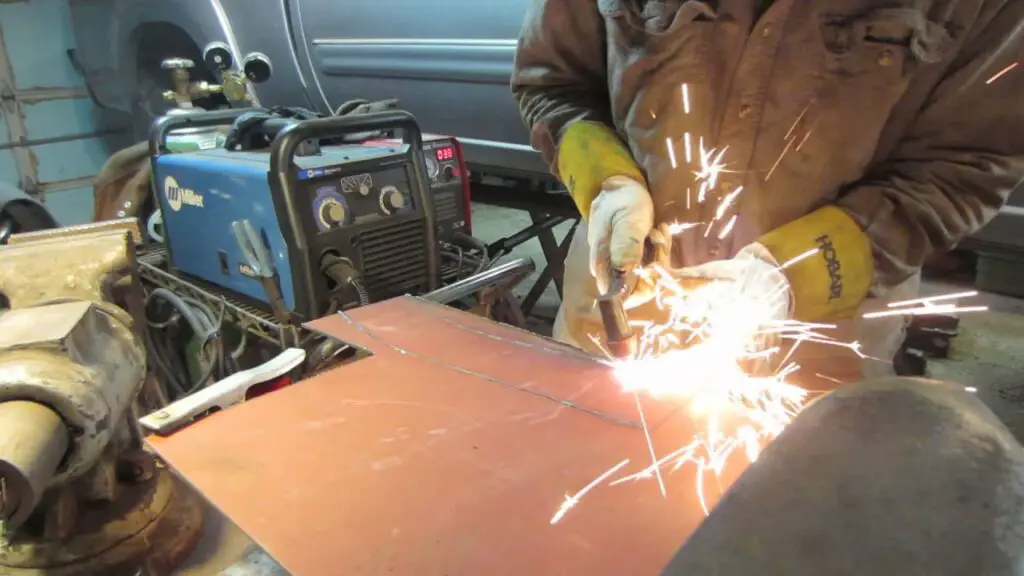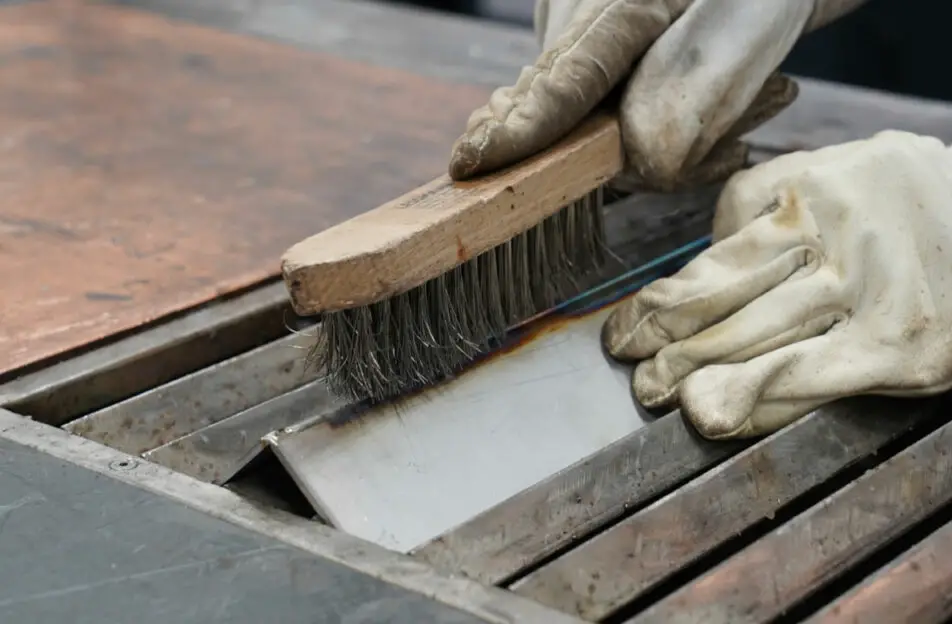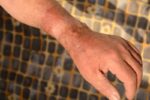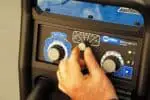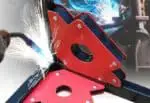A clean work area is one of the golden standards of producing a robust and nice looking weld. However, you may not always be fortunate enough to have a flawless workpiece.
The issue is that metals are extremely strong, yet they rust when they come into touch with water or moisture in the external environment.
As a result, dealing with rusted materials is one of the most regular issues you’ll face as a welder.
So before you begin, make sure steel surfaces should be cleansed of any pollutants such as oil, rust, and grease.
It is possible to weld rusted metal, however, in most circumstances, it will not provide the best-looking weld. But there are times when you will need to set things aside and weld them anyway. And if you have the right welding procedure and consumables for the application, you can weld rusted metals.
Rusted metal cannot be welded for important work because it reduces tensile strength and generates many defects. You should also take extra steps to protect yourself from excessive fumes.
What are the issues you might encounter while welding rusty metals?
Let’s take a closer look at the consequences of rust on welding.
1.) Reduced tensile strength.
Rust is an iron oxide, which means that it includes oxygen. The arc will degrade some of these oxides and make it weak.
And in the weld metal, oxygen will react with alloying components and the decrease of these parts reduces the tensile strength of the overall joint.
2.) A shaky arc and lots of splatter
When you weld, the contaminants cause an unstable arc, which results in more sparks and splatter.
3.) Inadequate fusion
Rust exacerbates the lack of fusion defects because it functions as a heat barrier. When the weld metal does not combine with the base metal and instead rests on top, this is referred to as lack of fusion. Lack of fusion is hazardous because it weakens the joint and is not visible to the untrained eye.
4.) Inadequate weld metal fluidity
Rust will also limit the flow of the puddle, making it stiffer and slower.
As a result, because the sides will not be filled with weld metal, the bead will be thin, asymmetrical, convex, and with undercuts.
5.) Inadequate electrical flow
Rust will obstruct the natural passage of electricity between the working clamp and the electrode. As a result, you’ll have difficulty starting the arc. The arc may not ignite at all if the rust is too thick.
6.) Inclusions and porosity
Rust, as previously stated, will cause oxygen to be released from the weld metal. Porosity is created by oxygen, which combines with other elements to form numerous inclusions.
Porosity and inclusions reduce the density of the bead and serve as mechanical and corrosion stress points.
As a result, the joint may fail under heavy loads, and if exposed to a corrosive environment, it may rust more quickly.
Here we give you a step by step method on how you can weld rusted metals.
Step 1: Thoroughly inspect the workpiece
The first step is to inspect the workpiece to determine the following.
The thickness of the metal- Welding may be difficult if the metal is exceedingly thin. You’ll almost certainly burn through the material. If the metal is thicker, you’ll have something to weld to, even if you have to burn through a few layers of rust to get to it.
The ins and outs of the metal- Then you must contemplate what is all on the metal. Rust is one thing, but adding dirt, grease, and paint to the mix can make your work much more difficult.
Intensity of corrosion on the metal- You must also establish how rusted the metal is. If the item has rusted all the way through, it may be impossible to weld. In other circumstances, you may need to cut off the problematic rusty part and weld a new piece of metal in to replace it.
Step 2: Select the Appropriate Welding Method
The welding procedure is determined by the state of the workpiece. MIG weld the metal if rust removal is possible. Otherwise, stick welding should be used for jobs where the rust cannot be removed by grinding.
Stick welding allows you to weld even when there are imperfections on the metal surface, and you can clear those particles out of the welding flux later.
Step 3: Start the welding process
Now that you’ve got everything set up, it’s time to make your first pass. There are a few things you should look at before you begin.
Check the type of wire or rod you’re using first.
For example- If you’re welding thinner metals at 1/8′′ or less, you should use a lower rod size like 3/32′′ or .035 wire.
Using a smaller wire may help avoid burn through, but you need also check another option.
Second, double-check your amp settings. If you’re welding anything thin that’s mostly rusted through, you’ll want to reduce the amperage to minimise burn through.
Step 4: Examine the welding quality
One of the biggest challenges with welding on rusted metal is that rust inclusions can impact weld quality. The first thing you should look for is porosity. It appears as little pinholes on the weld’s surface.
This symbol shows that gas bubbles are trapped within the weld, reducing the weld strength. If you notice these pinholes, grind down the weld and repeat the welding procedure.
Step 5: Examine and clean your welds
You need to inspect the weld now that you’ve completed the first pass. Here are a few things to keep an eye out for.
Weld should be cleaned- First, clean the weld with a wire brush. This will enable you to spot the flaw in the weld. If there is a crack or porosity, this can assist you detect it.
Porosity- If the weld has a lot of pinholes in it, it’s probable that the gas mixture and rust are to blame. If your weld has this, it is most likely a weak weld that has to be ground out and rewelded.
Step 6: Complete your welds
Finally, if everything seems fine, you may proceed with the final welds. With each pass, make careful to double-check that everything is in order. If things begin to change, you must act quickly to work on the defects before they worsen.
So, if you’re welding a rusted piece of metal, keep these fundamental measures in mind to ensure a good weld.
Why is stick welding considered the best welding technique?
Since covered welding rods are used, stick welding is the ideal welding procedure for rusty metals. These rods generate a powerful arc that may burn the rust.
Also, the flux coating produces slag material, which cleans the puddle. Because stick welding is so portable, it’s ideal for fast repairs on rusty metals.
Stick welding electrodes are constructed using a wire core and a flux covering. The flux coating produces slag that has a high concentration of deoxidizers and other scavengers, trapping most impurities and driving them to the surface.
Another key benefit of stick welding is the use of cellulosic flux rods.
Is welding rusty metals harmful for you?
Because pure rust renders the arc unstable, it can aggravate the fume production problem. However, if there are paint or grease remnants mixed in with the corroded metal, the situation might deteriorate. The ensuing vapors will be more complicated and, as a result, more dangerous for your health.
To be safe, keep your head away from the fume flow at all times and use a welding respirator and a proper mask and helmet.
And if you attempt to remove part of the rust, you must avoid breathing the dust that will be produced.
For rusty metal, a N95 respirator or filter is sufficient. Even so, if the rust contains paint or oil remnants, you’ll need further protection.
Conclusion
Welding on rusty metal may be difficult, and the odds of a good weld are dependent on a number of factors.
However, with the appropriate skills and proper technique, such welding tasks may be completed effectively.
But you should remember that welding rusted metals hardly creates an aesthetically pleasing weld.

